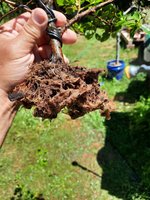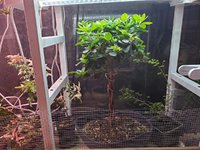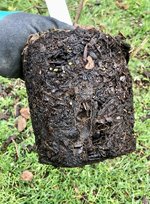Deep Sea Diver
Imperial Masterpiece
Gosh, I’m always mystified with the different information I get from various sources, online, books by “experts” articles written by practitioners.
For only one example, well two, and not to take this as a knock please, it’s just an example of the confusion I have faced in the past five years with bonsai advice.
Recently a very respected BNutter wrote:
… International Bonsai #54 Developing Informal upright style Azalea Bonsai was the first article I found after a 5 minute search.
“….Care of roots. After pruning the branches The roots should be cleaned out. First remove old soil with a root hook or chopstick. Remove thick roots with a concave pruner or knob cutter. The gently remove further soil gently with a chopstick….“
Now wait for it….
“The final soil should be removed with a high pressure hose or a strong spray from a garden hose. The roots should be bare without any old soil. Cut the roots to fit into a training container.” (The second advice doesn’t mention temperature of the wash water.)
I should note here this wasn’t a one off. I’ve read this before in satsuki articles before.
So being very inquisitive of nature and one who doesn’t like absolutes, I tried out both methods over the past years, just to see which method worked best. Tub washing with a chopstick and a gentle flow on the water wand and using my watering wand up to full bore at times with a chopstick to clear alway all of the soil. Both lived and both responded similarly over time.
I used whatever temperature came out of the water faucet. It was usually pretty darn cold.
The only exceptions on recover times were when dead patches of roots were discovered, or big roots impeding a good nebari were reduced. As would be expected, these trees where the roots were impaired or need to be cut back took longer to recover, yet recover they did. In similar time frames with others that had their roots reduced.
Keep in mind it is my normal practice to trim the roots on initial rootwashing/repotting so that the azaleas have a good start on a nebari. Roots first after all. This sometimes lead to some solid root mass reductions. If this occurs Sphagnum moss is gently packed into key places of the nebari/roots in an effort to enhance growth.
A couple recent images, just for ground truth. Both methods.
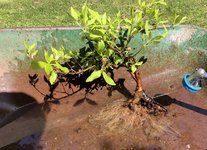

Now one could always say to me, “Sure, it worked for you in a couple cases, but…. that was only a couple azaleas. Maybe you got lucky or were sloppy in observing.” Hmm…. Absolutely don’t expect any give on my part here. Why?
Over the past four years I’ve done both procedures to over a hundred different azaleas. Multiple ages from 3 to over 20 yoa.
obtw: Since I was getting similar results by last year I flat gave up root washing in a tub, except for certain cases, in lieu of hose root washing. It’s generally faster and where the grower has used a gritty blend of media, like Riverbend or lots of bark chips like Kusa-farm and Nuccios this is pretty much the very best option.
Here’s the upper deck with over 50 rootwashed (either way) azaleas.
oh yes, I plant all of my rootwashed azaleas in 90/10 Kanuma/Pumice. It works even in the torrential rains in a PacNW spring. This may or may not work for you. Your tree your choice of media.

Of course aftercare is very important. I don’t do anything special. If its cool outside they might go into a cold frame or on the greenhouse shelf for a couple days until the weather moderates. Then up on the bench basically in morning sun and afternoon shade. Sometimes I water, sometimes not.
One thought: Does that mean everyone, especially the first timer should waterwash their azalea roots with a waterwand up to on full force and a chopstick in hand this?
Whoa! Not so fast if you are new to this. I’d recommend going slow for the first couple azaleas. Use a tub, chopstick and a gentle flow on your water wand, just to get a really long close up view of the lay of azalea rootland. After all, one should crawl and then walk before attempting running. But after that… Katie bar the door!
After all that I’m a bit more hesitant to accept blanket advice and absolutes in bonsai. I listen take it in and test out the ideas, then make up my own mind from there on.
Oh yes! In another case I was told on BN by another very respected member…”One can not, absolutely not grow azalea whips without a greenhouse.” (This was before I installed two myself. I still dont use it to grow whips…).
And….being very inquisitive of nature and one who doesn’t like absolutes, I tried to grow whips on my own… check out the bench
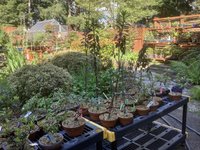
Ok I hope everyone takes this thread in good humor and with an open mind. I’m certainly not trying to demean anyones expertise, knowledge or years of working with bonsai. I totally respect you all and appreciate the chance to participate with so many awesome, incredible folks! I’m just pointing out what all of us know… sort of… that bonsai isn’t a perfect art…. Often it depends.
cheers! Now I gotta get back to work, those darn trees don’t wire themselves!
DSD sends
For only one example, well two, and not to take this as a knock please, it’s just an example of the confusion I have faced in the past five years with bonsai advice.
Recently a very respected BNutter wrote:
- “Never, ever “blast” the nursery soil out with high pressure water. You’ll kill gajillions of root hairs. Tease out as much soil as you possibly can, and then gently swish the root mass in a five-gallon bucket of lukewarm water to remove the rest.”
… International Bonsai #54 Developing Informal upright style Azalea Bonsai was the first article I found after a 5 minute search.
“….Care of roots. After pruning the branches The roots should be cleaned out. First remove old soil with a root hook or chopstick. Remove thick roots with a concave pruner or knob cutter. The gently remove further soil gently with a chopstick….“
Now wait for it….
“The final soil should be removed with a high pressure hose or a strong spray from a garden hose. The roots should be bare without any old soil. Cut the roots to fit into a training container.” (The second advice doesn’t mention temperature of the wash water.)
I should note here this wasn’t a one off. I’ve read this before in satsuki articles before.
So being very inquisitive of nature and one who doesn’t like absolutes, I tried out both methods over the past years, just to see which method worked best. Tub washing with a chopstick and a gentle flow on the water wand and using my watering wand up to full bore at times with a chopstick to clear alway all of the soil. Both lived and both responded similarly over time.
I used whatever temperature came out of the water faucet. It was usually pretty darn cold.
The only exceptions on recover times were when dead patches of roots were discovered, or big roots impeding a good nebari were reduced. As would be expected, these trees where the roots were impaired or need to be cut back took longer to recover, yet recover they did. In similar time frames with others that had their roots reduced.
Keep in mind it is my normal practice to trim the roots on initial rootwashing/repotting so that the azaleas have a good start on a nebari. Roots first after all. This sometimes lead to some solid root mass reductions. If this occurs Sphagnum moss is gently packed into key places of the nebari/roots in an effort to enhance growth.
A couple recent images, just for ground truth. Both methods.


Now one could always say to me, “Sure, it worked for you in a couple cases, but…. that was only a couple azaleas. Maybe you got lucky or were sloppy in observing.” Hmm…. Absolutely don’t expect any give on my part here. Why?
Over the past four years I’ve done both procedures to over a hundred different azaleas. Multiple ages from 3 to over 20 yoa.
obtw: Since I was getting similar results by last year I flat gave up root washing in a tub, except for certain cases, in lieu of hose root washing. It’s generally faster and where the grower has used a gritty blend of media, like Riverbend or lots of bark chips like Kusa-farm and Nuccios this is pretty much the very best option.
Here’s the upper deck with over 50 rootwashed (either way) azaleas.
oh yes, I plant all of my rootwashed azaleas in 90/10 Kanuma/Pumice. It works even in the torrential rains in a PacNW spring. This may or may not work for you. Your tree your choice of media.

Of course aftercare is very important. I don’t do anything special. If its cool outside they might go into a cold frame or on the greenhouse shelf for a couple days until the weather moderates. Then up on the bench basically in morning sun and afternoon shade. Sometimes I water, sometimes not.
One thought: Does that mean everyone, especially the first timer should waterwash their azalea roots with a waterwand up to on full force and a chopstick in hand this?
Whoa! Not so fast if you are new to this. I’d recommend going slow for the first couple azaleas. Use a tub, chopstick and a gentle flow on your water wand, just to get a really long close up view of the lay of azalea rootland. After all, one should crawl and then walk before attempting running. But after that… Katie bar the door!
After all that I’m a bit more hesitant to accept blanket advice and absolutes in bonsai. I listen take it in and test out the ideas, then make up my own mind from there on.
Oh yes! In another case I was told on BN by another very respected member…”One can not, absolutely not grow azalea whips without a greenhouse.” (This was before I installed two myself. I still dont use it to grow whips…).
And….being very inquisitive of nature and one who doesn’t like absolutes, I tried to grow whips on my own… check out the bench

Ok I hope everyone takes this thread in good humor and with an open mind. I’m certainly not trying to demean anyones expertise, knowledge or years of working with bonsai. I totally respect you all and appreciate the chance to participate with so many awesome, incredible folks! I’m just pointing out what all of us know… sort of… that bonsai isn’t a perfect art…. Often it depends.
cheers! Now I gotta get back to work, those darn trees don’t wire themselves!
DSD sends

